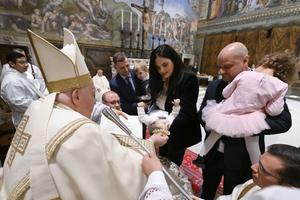Lessons From 15 Visits to the Sistine Chapel
What iconic art and a ceiling at the Vatican can teach us about faith and life

All Things Move
By Jeannie Marshall
Biblioasis, 2023
240 pages, $25.95
To order: amazon.com
If all Michelangelo ever created was David, with its incredible portrayal of youthful vitality, or the sublime Pietà, which was miraculously carved by his hands out of a single gigantic block of marble, it would have been enough to seal his place in history.
But then there’s the Sistine Chapel. The amount of artistic work inside is almost too much for the mind to comprehend, especially while being jostled by hundreds of tourists as you crane your neck to see the enormous portrayal of God touching Adam.
To visit is to be bombarded with imagery that stretches from the earth to the heavens, from creation to Noah and the Great Flood to Christ. There are the Jewish prophets and the sibyls, the pagan seers who were said to predict the coming of Christ and the triumph of Christianity.
Going once or even twice is not enough to absorb its totality.
Canadian author and journalist Jeannie Marshall, who has lived in Rome for 20 years with her husband and son, wanted to understand the chapel in a way that would take her deeper into its mysteries.
The result is a sublime meditation on the Sistine Chapel called All Things Move.

In her telling, she needed to focus on something greater than herself, and perhaps greater than all of us.
She wanted to find something that could somehow heal her grief over the loss of brothers and sisters who died way too young, as well as help her to make some sense of this tragedy.
“I knew the Sistine Chapel frescoes would be complex — full of theology, history and artistry,” she said in an interview with the Register.
“I needed something big, enduring and meaningful to match the sense of loss. Michelangelo is also gone, but his work remains, so perhaps what I wanted was continuity and a sense that not everything is lost in this world when we die.”
Opus Dei Father Eric Nicolai, a priest based in Toronto who holds a master’s degree in art, told the Register that the Sistine Chapel exposes Michelangelo’s own personal troubles.
“Michelangelo’s ceiling reflects the artist’s very personal inner turmoil, his fascination with agony, ecstasy, sensuality, passion, drama — all qualities that are experienced by a conflictive personality who took very seriously his own judgment in front of God,” Father Nicolai said.
Marshall’s first encounter with the Sistine Chapel was in her French-Canadian, and deeply devout, grandmother’s home in Toronto.
“The first image I can recall seeing of the Sistine Chapel was a picture my grandmother showed me of God and Adam,” she writes. “She told me it would be so wonderful to see it. There was such reverence in her voice, as though she were saying how wonderful it would be to see the face of God …”
I visited the Sistine Chapel three times over several weeks while visiting Rome a decade ago. I wish I could have read a book like All Things Move before seeing it for the first time. It would have prepared me on how to look at something so important in Catholic art and the world of art in general.
I would have even loved to have even read this single excerpt from Marshall’s book:
“To stand in the room and look at the images and allow them into your life, to wrap themselves around your own memories, and to feel what a great work of art means to you is another thing entirely. To revisit after a big event in your life or in the world provides an opportunity to see the changes in you reflected in it.”
Many of the Sistine’s great works of art — frescoes by such great Italian artists as Ghirlandaio, Botticelli and Pietro Perugino from Umbria — are often missed by visitors, she explained. They, too, are part of the story and need to be tied into the Sistine Chapel as a whole.
That sense of unity is important in terms of all the Church teaches.
Together, said Father Nicolai, the Sistine Chapel can be seen as part of the Church’s evangelization of the world.
“The Church has long been the patron of great art because it is intimately involved in the noblest and important task in history: preserving the integrity of the message of Christ and making him loved in truth,” he said.
“Pope Francis would call that the joy of the Gospel. The Sistine Chapel is so closely associated with this task, with its papal liturgies and the conclave, that it necessarily becomes a place of great beauty.”
During Marshall’s first few visits, she writes that she felt “irritation and confusion” as she tried to wrestle myriad images into a cohesive whole. That meant understanding the peripheral stories, particularly the frescoes.
But after 15 visits, it all began to make sense:
“The images in the Sistine Chapel are not simply biblical illustrations; they are also the product of an intellectual culture, of the ideas of the most influential artists of the Renaissance and of the consequences of historical events. Out of a sense that seeing this work could yield some insight into the past and the present, that it could lead me to see something of the world of now that we all inhabit and that world in relation to my own life, I decided to persevere.”
She adds, “I wish every visitor to the Sistine Chapel could find it as exhilarating as I do now after all these years of visiting it.”
- Keywords:
- sistine chapel
- sacred art
- michelangelo

















